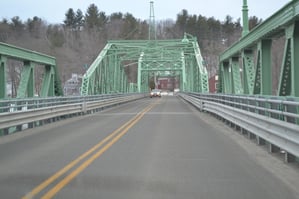With the arrival of spring and (finally) the end of heavy snow, I recently traveled to the Boston area on business, venturing north to make a few sales calls and inspect a bridge in northeastern Massachusetts. In the summer of 2013, Composite Advantage supplied the world’s largest FRP deck on Haverhill’s Rocks Village vehicle bridge. The six-span steel truss structure was built in 1883 and is the state’s oldest moveable bridge. Its swing span [span 3] permits passage of boats and barges. Critical weight requirements coupled with historic classification standards made FRP the best option for the 2013 project. The new deck added 18,800 square feet of new driving surface to the bridge!
When I first arrived at the bridge, I noticed two things:
- The bridge and deck look great.
- The bridge handles a lot of traffic.
Since there is rarely an issue with the basic panels themselves, I focused my inspection on the joints and connections. Guard rail attachment posts are fastened to the FRP deck. All these connections looked good and solid.

The panel-to-panel joints looked the same as they had immediately following installation. After the wear surface was field applied, control joints were cut where reflective cracking is most likely to occur: above the panel joints. Also, there were no additional openings at the control joint due to thermal expansion. This was very important - it means water (with salt and chemicals) cannot seep between the deck panels to affect the steel below. When I looked underneath the bridge, I saw no evidence of water coming through the deck panel joints.
I also inspected the span joints, especially at the swing span. The end panels contain steel impact plates, and the swing span end panels are curved so that span number 3 can rotate when the bridge needs to be opened. The gap between spans looked very consistent, without any evidence of interference. Wear surface adherence to the deck and around the rail post looked very good.
After the bridge inspection, I met with MassDOT bridge engineers. We discussed the Rocks Village bridge deck, and they hadn’t heard any negative comments. In the hectic DOT world, ‘no complaints’ is very good news, indeed.
For more information on the Rocks Village bridge or anything else, contact us today.
